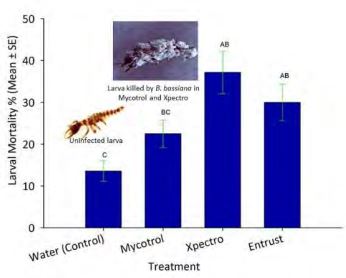Toxicity of three bio-pesticides on first instar larvae of biological control agents Chrysoperla carnea (Neuroptera: Chrysopidae) and two-spotted ladybeetle Adalia bipunctata (Coleoptera: Coccinellidae)
Principal Investigator: Gadi V.P. Reddy
Project Personnel: Govinda Shrestha, Ramadevi L. Gadi and Debra Miller Western Triangle Agricultural Research Center, Montana State University, 9546 Old Shelby Rd., P.O. Box 656 Conrad, MT 59425, USA
Aim of the Study
The aim of the study was to test the toxicity of three bio-pesticides: 1) Mycotrol ESO® (Beauveria bassiana GHA), 2) Xpectro OD® (B. bassiana GHA + Pyrethrin) and 3) Entrust WP® (spinosad 80%) on the two natural enemies (lacewing and ladybeetle). Consideration for these three bio-pesticides for study was primarily because they were found to be potential control agents for pea leaf weevil Sitona lineatus (L.) (Coleoptera: Curculionidae) management in field peas. Both beneficial insects are the most common species in Montana agricultural crops including field peas.
Material and Methods
Beneficial insect species: Green lacewing and ladybeetle larvae
Green lacewing Chrysoperla carnea Stephens (Neuroptera: Chrysopidae) and two-spotted ladybeetle Adalia bipunctata L. (Coleoptera: Coccinellidae) first instar larvae were obtained from Biobest Canada Ltd. (www. biobestgroup.com). Flour moth eggs, Ephestia kuehniella Zeller (Lepidoptera: Pyralidae), were obtained from Beneficial Insectary, CA (www.insectary.com). The flour moth eggs were used as a source of food materials for rearing the aforementioned two beneficial insect species.
Bio-pesticide products and rates
Mycotrol ESO® (Beauveria bassiana GHA) and Xpectro OD® (Beauveria bassiana GHA + pyrethrins) were obtained from Lam International (Butte, MT). Entrust WP® (spinosad 80%) was received from Dow Agro Sciences (Indianapolis, IN). For this non-target experiment, the bio- pesticides were applied at concentrations of 1.44 ml/L (Mycotrol), 5 ml/L (Xpectro) and 0.182 g/L (Entrust), which correspond to the doses recommended by the manufacturers for agricultural practices. Furthermore, the selected concentrations were shown previously to be effective on killing pea leaf weevil adults.
These three products were chosen primarily for the non-target experiment because they were recently found as potential control agents for pea leaf weevil management in field peas.
Lacewing and ladybeetles are the most naturally occurring beneficial insect species in Montana agricultural crops including field peas.
Laboratory bioassay
The bioassay experiment was performed to determine the toxicity of Mycotrol, Xpectro and Entrust bio-pesticide products on the first instar larvae of lacewing and two-spotted ladybeetles.
Similar sized larvae of each beneficial insect species were placed in groups of 10 individuals in a Petri dish (diameter = 9 cm). Placement of the larvae was accomplished with the help of a fine camel paint brush, and placed in the center of Petri dish. Each bio-pesticide product was sprayed topically to test individuals using a 750 ml hand-held sprayer, with a spray volume of 1 ml per Petri dish. Controls were treated with 1.0 ml of tap water.
Immediately after spraying (about 5 sec), the bio-pesticide exposed larvae were transferred individually to plastic deli cups with an excess of E. kuehniella eggs. Dishes were incubated in a climate cabinet at 22 ± 1 ºC, 16:8 L: D and 75% RH.
Beginning from day one after the treatment, larval mortality was checked at one-two days interval for seven days. Dead larvae, particularly from insect pathogenic fungi (Mycotrol) or mixture with other product (Xpectro), were removed and placed on moist filter paper in a Petri dish to check for sporulation. The bioassay experiment was performed 2-3 times within a period of two months (November-December, 2017). The numbers of replicates (one replicate = one Petri dish) per treatment was three in each experimental run (providing a total of six to nine replicates per treatment).
Statistical analysis
One-way ANOVA was performed to determine the toxicity of three bio-pesticide products on the lacewing and ladybeetles larvae, as measured via total larval mortality. Tukey test was used as a post hoc test for multiple comparisons between the means at probability (α = 0.05). The data was analyzed using the software statistical package R 2.15.1 (R Development Core Team, 2017).
Figure 1. Toxicity of three bio-pesticide products against the first instar ladybeetle larvae. Bars bearing the same letters are not significantly different (Tukey test, P > 0.05). The total number of replicates per treatment was six.
Results
Ladybeetle larval mortality
This study reported that the treatments had significant impact on ladybeetle larval mortality (df = 3, 20; F = 28.4; P = 0.0001). Among the three bio-pesticide products, Xpectro was found to be highly toxic to ladybeetle larvae, causing nearly 98 ± 1.66 % (Mean ± SE) mortality when compared to the control treatment (11.67± 6.54). However, Mycotrol and Entrust were inflicting minimal larval mortality and were not significantly different when compared to the control treatment (Fig 1).
Lacewing larval mortality
Generally, lacewing larvae were found to be less susceptible to the three tested bio-pesticide products in comparison to the ladybeetle larvae. However, significant differences were recorded between treatments (df = 3, 32; F = 6.66; P = 0.0013). Among the three bio-pesticide products, Xpectro (Mean ± SE; 37.16 ± 5.06) was causing the high mortality followed by Entrust (Mean ± SE; 30.00 ± 4.40) and Mycotrol (22.46 ± 3.22) when compared to the control treatment (Mean ± SE; 13.58 ± 2.45). There was no significant difference in treatments between water and Mycotrol, indicating that this product is less toxic to lacewing larvae (Fig 2).
Figure 2. Toxicity of three bio-pesticide products against the first instar lacewing larvae. Bars bearing the same letters are not significantly different (Tukey test, P > 0.05). The total number of replicates per treatment was nine.
Acknowledgements
This study was supported by USDA/Montana Specialty Crop Block Grant, Award# 15SCBGPMT0005
References
R Development Core Team (2017) R: a language and environment for statistical computing. R Foundation for Statistical Computing, Vienna. Available: http://www.R-project.org. Cited 19 December 2017


